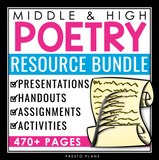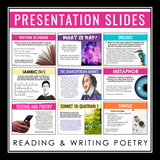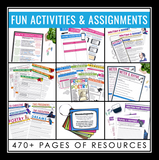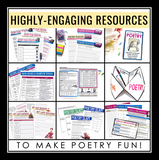Poetry Unit - Poem Analysis and Writing Bundle - Presentations and Assignments
This poetry unit bundle is a collection of my most popular and best-selling poetry analysis and writing resources! Make poetry fun and engaging for your students with this huge bundle containing over 470 slides and pages of creative activities, presentations, quizzes, handouts, and poetry-writing projects—all designed to save you hours of prep time. It includes absolutely everything you need to teach figurative language, poetry analysis, poetry writing, and more. This bundle gives you an incredible amount of flexibility, offering months worth of poetry resources that you can mix, match, and use in any order to fit the needs of your students. Instead of locking you into a fixed day-by-day sequence, it provides a wide variety of creative, ready-to-use materials you can plug into any poetry unit to enhance your lessons.
What Teachers are Saying About This Poetry Unit:
⭐️⭐️⭐️⭐️⭐️ Definitely worth the money!!!! An awesome product, lots of time, creativity, and work went into this. Thank you, poetry is one of my favorite units to teach, and it just got better!!!!
⭐️⭐️⭐️⭐️⭐️ This was well worth the price, and after exploring the resources, I know I would have paid more!
⭐️⭐️⭐️⭐️⭐️ Just started going through this purchase and it looks even more amazing than I thought. Tons of info and exciting activities. It's going to be perfect! Thanks :)
Included in this Poetry Unit Resource Bundle:
General Poetry Resources
➡️ Poetry Introduction Booklet - Student Reference: This foldable student handbook gives your class an easy, go-to reference during your poetry unit for the most important poetry concepts, including rhyme scheme, internal rhyme, meter, stanza types, figurative language, and common poetry forms like haiku, acrostic, and sonnet. Just print double-sided, fold, and your students will have a clear, structured guide they can use throughout your entire unit.
➡️ Literary Devices Figurative Language Reference List: This three-page figurative language list provides clear definitions and memorable examples pulled from poems, literature, movies, and children’s stories. It covers all the essential devices—metaphor, simile, personification, hyperbole, imagery, symbolism, onomatopoeia, alliteration, consonance, assonance, oxymoron, and more—so students always have a reliable reference during analysis.
➡️ Poetry Desk Tags Student Reference: These ready-to-use desk tags give your students instant access to key poetry terms right at their desks. Simply print, laminate, and tape to desks so when students ask, “What’s onomatopoeia again?” or “What do you call a four-line stanza?” you can direct them to the resource right in front of them.
Figurative Language or Poetry Devices Resources
➡️ Figurative Language in Song Lyrics Presentation: This 13-slide presentation introduces figurative language through high-interest song lyrics from artists your students already know—Taylor Swift, Drake, Billie Eilish, Rihanna, and more. Each slide defines a term and pairs it with a real lyric example, making your figurative language introduction instantly engaging and relevant.
➡️ Poetry Terms Figurative Language Introduction Presentation: This 26-slide slideshow walks students through 13 essential poetry terms with clear definitions and examples from poetry and everyday life. It includes a student note-taking template and printable definition slides you can use as classroom posters or a poetry wall reference.
➡️ Poetry Terms Folding Fortune Teller Activity: This hands-on activity helps students internalize figurative language through a foldable paper fortune teller. With step-by-step folding instructions, teacher ideas for using it in class, and three versions included, this resource makes reviewing metaphor, simile, onomatopoeia, personification, imagery, symbolism, alliteration, and hyperbole both interactive and fun.
➡️ Meter and Rhyme in Poetry: Understanding Poetic Form: This lesson helps students understand how sound and rhythm contribute to meaning in poetry. You’ll get a 17-slide presentation introducing poetic meter, rhyme scheme, and types of rhyme, plus a practice assignment using a Samuel Taylor Coleridge poem and a detailed teacher answer key for easy review.
➡️ Figurative Language Poetry Terms Flashcards and Posters: These printable flashcards and full-page posters make reviewing essential poetry devices simple and effective during your poetry unit. Each card includes a definition and example, and the included teacher instructions offer multiple ideas for using them in stations, warm-ups, partner practice, or classroom display.
➡️ Figurative Language Poetry Terms Quiz: This ready-to-use two-page quiz checks student understanding of figurative language in authentic poem excerpts. Students label the device and explain how it’s used, and the included answer key provides definitions, explanations, and text evidence to make grading or whole-class review quick and stress-free.
Reading or Analyzing Poetry Resources
➡️ Poetry Annotation How-To Guide: This step-by-step resource teaches students exactly how to annotate a poem with confidence. It includes a presentation walking through the seven steps of annotation, a student handout outlining each step, and an annotation practice activity using stanzas from Wordsworth’s “I Wandered Lonely as a Cloud.” A completed sample annotation and detailed teacher notes support easy modelling and review.
➡️ Poetry Analysis Assignments for Six Poems: These ready-to-use assignments help students analyze six engaging poems through comprehension and analysis questions that require text evidence, inference, and deeper thinking. Each poem includes a student assignment page, detailed answer key with text evidence, and a presentation to model the responses with the class.
➡️ Because I Could Not Stop for Death by Emily Dickinson Resources: This lesson takes students through Dickinson’s symbolic and eerie exploration of mortality. A 30-slide presentation guides the lesson, and students complete an annotation assignment, a symbolism analysis, and comprehension questions—each with a detailed teacher key. A creative writing task invites students to rewrite the poem from Death’s perspective using poetic techniques.
➡️ Poetry Playlist: Analyzing 3 Songs as Poetry: These assignments help students analyze song lyrics as poetry using three popular songs: “Imagine” (John Lennon), “Midnight Rain” (Taylor Swift), and “Lose You to Love Me” (Selena Gomez). Each assignment includes five analysis questions requiring text evidence, detailed answer keys, and a 16-slide review presentation.
➡️ My Last Duchess by Robert Browning Resources: This ready-to-use pack helps students analyze Browning’s dramatic monologue with a 26-slide presentation and four activities: an annotation assignment, comprehension questions, a Duke characterization task, and a creative writing activity from the Duchess’s perspective. Each assignment includes a detailed teacher answer key.
➡️ Poetry Rap - Using Rap Song Lyrics to Teach Poetry: This resource bridges poetry and rap during your poetry unit through a 26-slide presentation that explores rhythm, rhyme, literary devices, storytelling, theme, and emotional impact. Students compare Tupac Shakur’s “Dear Mama” with Langston Hughes’ “Mother to Son,” then complete a creative writing activity where they produce their own rap lyrics. Teacher keys and guides are included.
➡️ The Road Not Taken by Robert Frost Resources: This complete lesson bundle includes a 29-slide presentation and three engaging activities: a stanza-by-stanza breakdown assignment, a deeper analysis task, and a creative rearranged-poem assignment where students reconstruct Frost’s poem using only the original words to write a brand-new piece. Detailed answer keys make review effortless.
➡️ Poetry Analysis Song Lyrics Project: This final project has students choose a song and analyze the lyrics for meaning, theme, and poetic devices. The resource includes a presentation to introduce the project, detailed student instructions, good copy graphic organizers, and an easy-to-use grading rubric.
➡️ The Soundtrack of My Life Assignment: Students select three songs that represent important moments in their lives and analyze one of them as poetry. They make text-to-self connections, examine theme, identify literary devices, and complete two polished graphic organizers. A presentation and rubric are included to guide and assess the project.
Writing Poetry Resources
➡️ Poetry Writing Unit Booklet: This booklet guides students through writing eight different types of poems with clear instructions, examples, and structured pages for drafting and final copies. Students learn to write a Bio Poem, I Am Poem, Haiku, Acrostic, Concrete Poem, Antonym Diamante, Limerick, and Quatrain. A presentation for each poem type supports easy teaching.
➡️ Poetry Slam Writing: Bring slam poetry into your classroom during your poetry unit with a presentation that covers its history, characteristics, rules, and strong video examples. Students brainstorm, plan, and write their own slam poem using the included graphic organizer, then present it. A teacher rubric makes assessment quick and straightforward.
➡️ Texting Poetry Writing Activity: This creative writing task invites students to write poems using texting conventions—abbreviations, acronyms, emojis, and digits. It includes a presentation, strategy handout, brainstorming graphic organizer, and two good-copy cell-phone-themed templates for publishing student poems.
➡️ Shakespearean Sonnets Analysis and Writing Resource: This resource walks students through iambic pentameter, rhyme scheme, and sonnet structure using Sonnet 18. Students complete annotation and analysis questions, then use a structured graphic organizer and checklist to write their own Shakespearean sonnet. A detailed presentation and answer keys are included.
What Teachers are Saying About Using This Poetry Unit:
⭐️⭐️⭐️⭐️⭐️ Fantastic! Everything you could ask for and more! This has positively all you could need to teach a successful and engaging poetry unit, no matter what your students' interest level. The powerpoints and accompanying activities are great. Thank you!
⭐️⭐️⭐️⭐️⭐️ Wow! This is a comprehensive package of great resources for any poetry teacher. I have been looking for a way to add interest, creativity, and cohesiveness to my poetry units, and this fits the bill. Thank you!
⭐️⭐️⭐️⭐️⭐️ AMAZING!! I'm running out of ink today just trying to get everything I want to use printed off! It's just so comprehensive! Not only print resources, but explicit, engaging power point presentations to use in conjunction with each lesson! Not only that, but entertaining activities and review ideas as well. I love the close reading and annotation lessons. Really hits the heart of what we need to be doing with our kids! Also love that you picked what I would consider to be the "must teach" poets/poems for middle school students. My kids are going to love this! Thank you! Can't wait to get started!
⭐️⭐️⭐️⭐️⭐️ Probably one of the best and most comprehensive purchases that I've made on here-- to the point that this is the first time I've ever felt compelled to rate a product.
⭐️⭐️⭐️⭐️⭐️ By far, one of the best resources I've come across on TPT. Thorough, detailed, informative, and fun!
© Presto Plans
➡️ Want 10 free ELA resources sent to your inbox? Click here!












